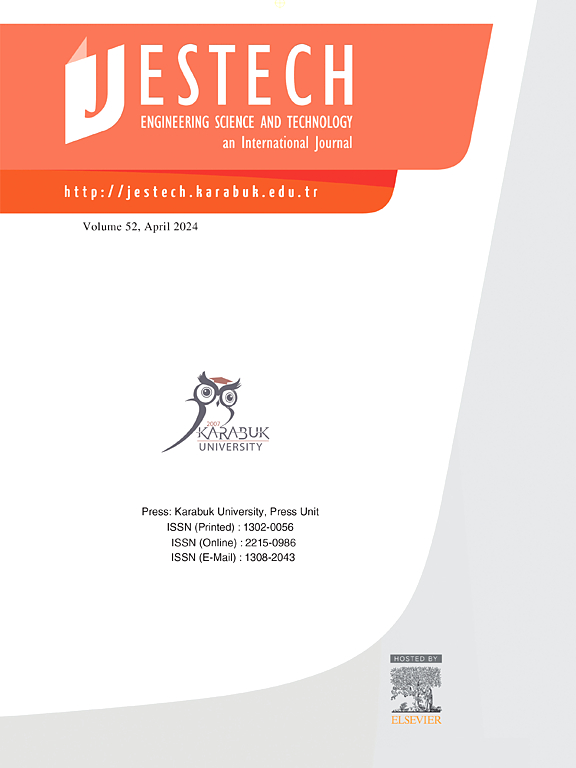设计绿色安全的微交通路线:基于先进地理分析决策系统的可持续城市基础设施方法
IF 5.4
2区 工程技术
Q1 ENGINEERING, MULTIDISCIPLINARY
Engineering Science and Technology-An International Journal-Jestech
Pub Date : 2025-03-04
DOI:10.1016/j.jestch.2025.102027
引用次数: 0
摘要
由于交通拥堵、环境问题和交通基础设施效率低下,城市交通面临越来越大的挑战。微交通解决方案作为一种可持续的替代方案已经获得了广泛关注,但将其融入城市交通网络仍然是一项复杂的任务。为此,本研究引入地理分析决策框架,优化微出行路径规划。该方法包括五个关键步骤:(i)识别和空间分析在地理信息系统(GIS)环境下影响微流动性采用的33个关键因素;(ii)使用最先进的加性权重模糊对数法(FLMAW)和模糊简单权重计算(Fuzzy SIWEC)加权方法生成路线的适宜性图。结果表明,自行车道、公共交通路线、地形倾斜度和休闲区等标准对微交通的使用有很大影响;(iii)在此基础上,共开发出21条优化路线,并通过Spearman秩相关分析验证其与主要标准之间的关系,结果显示出显著且强的正相关关系;(iv)此外,采用随机森林分类法将路线划分为9个不同的使用类别。已经创建了具有不同昵称的路由类,如GreenLink和UrbanHealth Path;(5)采用DOmbi Bonferroni (DOBI)性能评价方法确定研究区路线建设的优先顺序。结果表明,R9和R10路线的建设优先级高于其他路线。该框架提供了一种可扩展的、适应性强的、数据驱动的和基于证据的方法,为旨在将微交通整合到可持续交通战略中的城市规划者和政策制定者提供了有价值的见解。本文章由计算机程序翻译,如有差异,请以英文原文为准。
Designing green and safe micro mobility routes: An advanced geo-analytic decision system based approach to sustainable urban infrastructure
Urban mobility faces increasing challenges due to congestion, environmental concerns, and inefficiencies in transport infrastructure. Micro-mobility solutions have gained significant attention as a sustainable alternative, yet their integration into urban transport networks remains a complex task. To this end, this study introduces a geo-analytic decision-making framework for optimizing micro-mobility route planning. The methodology consists of five key steps: (i) identification and spatial analysis of 33 critical factors influencing micro-mobility adoption in a Geographic Information Systems (GIS) environment; (ii) a suitability map for the routes was generated using the state-of-the-art Fuzzy Logarithm Methodology of Additive Weights (FLMAW) and Fuzzy Simple Weight Calculation (fuzzy SIWEC) weighting methods. It was determined that criteria such as cyclist lanes, public transportation routes, terrain inclination, and recreational areas have a high impact on micro mobility use; (iii) based on this analysis, 21 optimized routes were developed, and their relationships with the main criteria were validated through Spearman’s rank correlation analysis, revealing a significant and strong positive correlation; (iv) additionally, Random Forest classification was applied to categorize routes into nine different usage classes. Route classes with different nicknames such as GreenLink and UrbanHealth Path have been created; and (v) DOmbi Bonferroni (DOBI) performance evaluation method was used to determine the preferred priority order for route construction in the study area. The results indicate that the construction priority of routes R9 and R10 is higher than that of other routes. The proposed framework offers a scalable, adaptable, data-driven, and evidence-based approach, providing valuable insights for urban planners and policymakers aiming to integrate micro-mobility into sustainable transportation strategies.
求助全文
通过发布文献求助,成功后即可免费获取论文全文。
去求助
来源期刊

Engineering Science and Technology-An International Journal-Jestech
Materials Science-Electronic, Optical and Magnetic Materials
CiteScore
11.20
自引率
3.50%
发文量
153
审稿时长
22 days
期刊介绍:
Engineering Science and Technology, an International Journal (JESTECH) (formerly Technology), a peer-reviewed quarterly engineering journal, publishes both theoretical and experimental high quality papers of permanent interest, not previously published in journals, in the field of engineering and applied science which aims to promote the theory and practice of technology and engineering. In addition to peer-reviewed original research papers, the Editorial Board welcomes original research reports, state-of-the-art reviews and communications in the broadly defined field of engineering science and technology.
The scope of JESTECH includes a wide spectrum of subjects including:
-Electrical/Electronics and Computer Engineering (Biomedical Engineering and Instrumentation; Coding, Cryptography, and Information Protection; Communications, Networks, Mobile Computing and Distributed Systems; Compilers and Operating Systems; Computer Architecture, Parallel Processing, and Dependability; Computer Vision and Robotics; Control Theory; Electromagnetic Waves, Microwave Techniques and Antennas; Embedded Systems; Integrated Circuits, VLSI Design, Testing, and CAD; Microelectromechanical Systems; Microelectronics, and Electronic Devices and Circuits; Power, Energy and Energy Conversion Systems; Signal, Image, and Speech Processing)
-Mechanical and Civil Engineering (Automotive Technologies; Biomechanics; Construction Materials; Design and Manufacturing; Dynamics and Control; Energy Generation, Utilization, Conversion, and Storage; Fluid Mechanics and Hydraulics; Heat and Mass Transfer; Micro-Nano Sciences; Renewable and Sustainable Energy Technologies; Robotics and Mechatronics; Solid Mechanics and Structure; Thermal Sciences)
-Metallurgical and Materials Engineering (Advanced Materials Science; Biomaterials; Ceramic and Inorgnanic Materials; Electronic-Magnetic Materials; Energy and Environment; Materials Characterizastion; Metallurgy; Polymers and Nanocomposites)
 求助内容:
求助内容: 应助结果提醒方式:
应助结果提醒方式:


